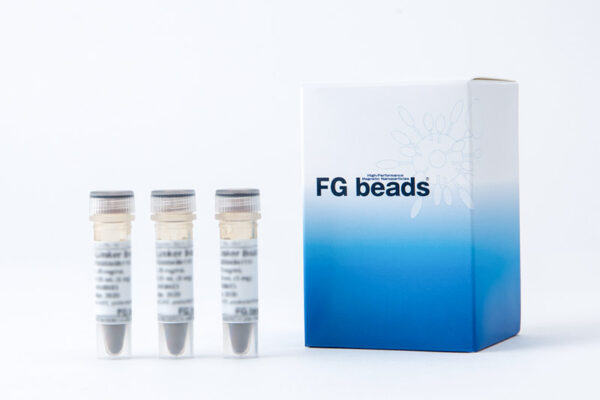Plain beads
Plain beads are a type of beads that do not have a linker (spacer).
DNA and RNA are directly immobilized on the epoxy group on the surface and used for purification of transcription factors and complementary DNA and RNA.


Magnetic beads
The lineup of this product is only regular FG beads.
| Beads | FG beads |
|---|---|
| Code | TAS8848N1010 |
| Price | Please contact us |
| Storage conditions | 2-8 ℃ (no freezing), protect from light |
| Storage buffer | Ultrapure water |
| Magnetization | Superparamagnetism (≧10 emu/g) |
| Size of beads | 180±30 nm |
| Concentration | 20 mg/ml |
| Functional groups | Epoxy groups |
| Amounts of the functional groups | Approx. 1 μmol/mg of beads |
- Protocol
- SDS
- Papers /
Technical Information - Related Products
- FAQ
Technical Information
Papers
-
Itpr1 regulates the formation of anterior eye segment tissues derived from neural crest cells
Development (2021) 148 (16): dev188755 -
Design and Trial Production of Magnetic Filter for Medical Protein Screening System using High Gradient Magnetic Separation
Journal of Physics: Conf. Series 1293 (2019) 012081 -
Comparative analysis of type 2 diabetes-associated SNP alleles identifies allele-specific DNA-binding proteins for the KCNQ1 locus
Int J Mol Med. 2015 Jul;36(1):222-30. -
M. Golan-Mashiach et al. (2012)
Identification of CTCF as a master regulator of the clustered protocadherin genes
Nucl. Acids Res., 40, 3378 (2012). -
A general mechanism for transcription regulation by Oct1 and Oct4 in response to genotoxic and oxidative stress
Genes Dev., 23, 208 (2009). -
Embryonic Lethality, Decreased Erythropoiesis, and Defective Octamer-Dependent Promoter Activation in Oct-1-Deficient Mice
Mol. Cell. Biol., 24, 1022 (2004). -
Regulation of Immunoglobulin Promoter Activity by TFII-I Class Transcription Factors
J. Biol. Chem., 279, 5460 (2004). -
Total Analysis and Purification of Cellular Proteins Binding to Cisplatin-Damaged DNA Using Submicron Beads
Bioconjugate Chem., 13, 163 (2002). -
Selective isolation of DNA or RNA using single-stranded DNA affinity latex particles
J. Colloid Interface Sci., 177, 245 (1996). -
Copurification of casein kinase II with transcription factor ATF/E4TF3
Nucleic Acids Res., 24, 876 (1996). -
[40] DNA affinity chromatography
Methods in Enzymology, 254, 595 (1995). -
Application of cationic latex particles for protein separation
Coll. Surf. B., 2, 419 (1994). -
Preparation of DNA-carrying affinity latex and purification of transcription factors with the latex
J. Biomater. Sci. Polym. Ed., 5, 293 (1994). -
Direct purification of multiple ATF/E4TF3 polypeptides from HeLa cell crude nuclear extracts using DNA affinity latex particles
Anal. Biochem., 206, 109 (1992). -
A Common trans-Acting Factor, Ad4-binding Protein, to the Promoters of Steroidogenic P-450s
J. Biol. Chem., 267, 17913 (1992). -
Purification of DNA-binding transcription factors by their selective adsorption on the affinity latex particles
Nucleic Acids Res., 17, 6229 (1989).
- Please tell me how to separate FG beads (magnetic separation and centrifugation).
- Please tell me how to disperse FG beads (ultrasonic method and manual method).
- I mistakenly frozen some beads that were supposed to be stored in the refrigerator. Is it available?
- What amount of the beads is required?
- What are the important points when designing a ligand?
- How are beads stored after the ligands are bound to them?
- Are there any methods other than HPLC for verifying whether or not ligand binding has been successful?
- How strong is the affinity for the proteins that are affinity purified?
- What is the purification efficiency?
- How is the cell extract prepared?
- Is there any problem with using frozen stock homogenate?
- How much protein supply is necessary?
- Can affinity purification be used with membrane proteins such as GPCRs and ion channels?
- There are many background bands. how can i reduce it?
- What should be done when a large number of bound protein bands are detected?
- Is it necessary to use the recommended buffer as the binding buffer?
- Why is it that both salt elution and boil elution are performed for elution?
- Does it happen that the band of bound protein becomes thin when the concentration of ligand is increased?
- Why can’t I see any bands of bound proteins?
- How long is the stable period of the ligand-immobilized beads?
- Is the optimal binding reaction time of 4 hours?
- What is the optimal bead type for binding DNA?
- What method is used to bind RNA?
- I want to analyze bound proteins with MS, but what should I do if the target protein band is thin?
- How much protein can be analyzed by MS?

